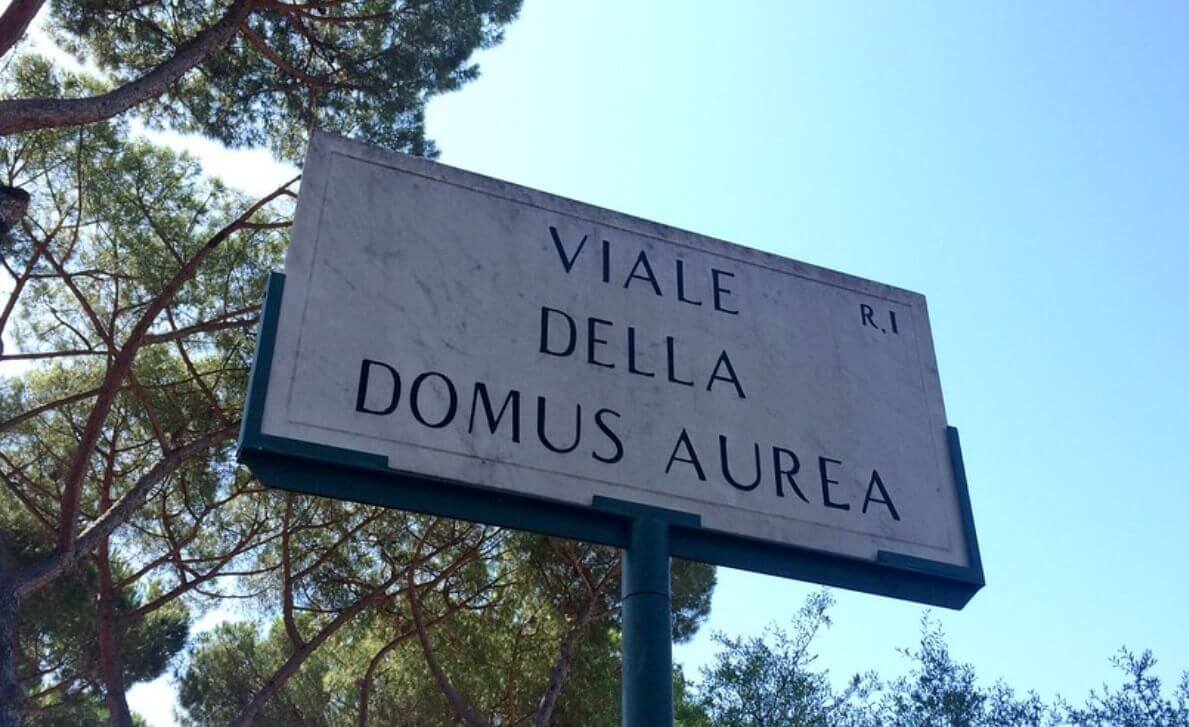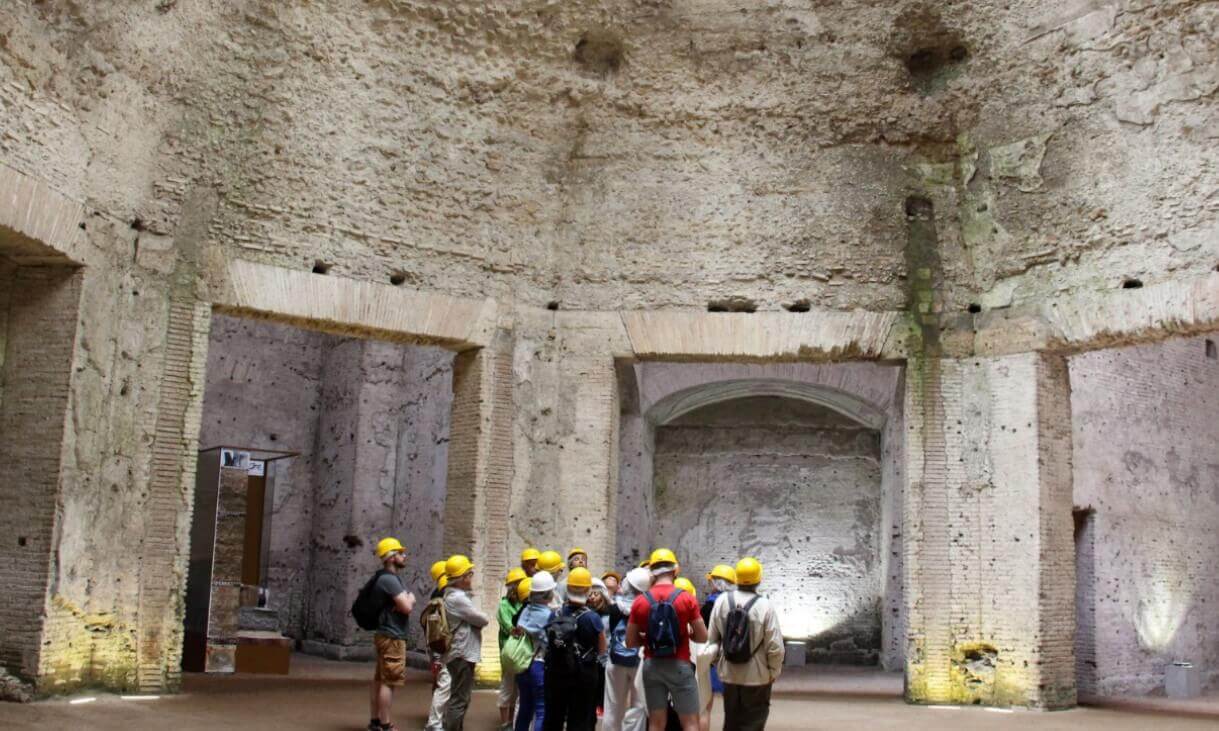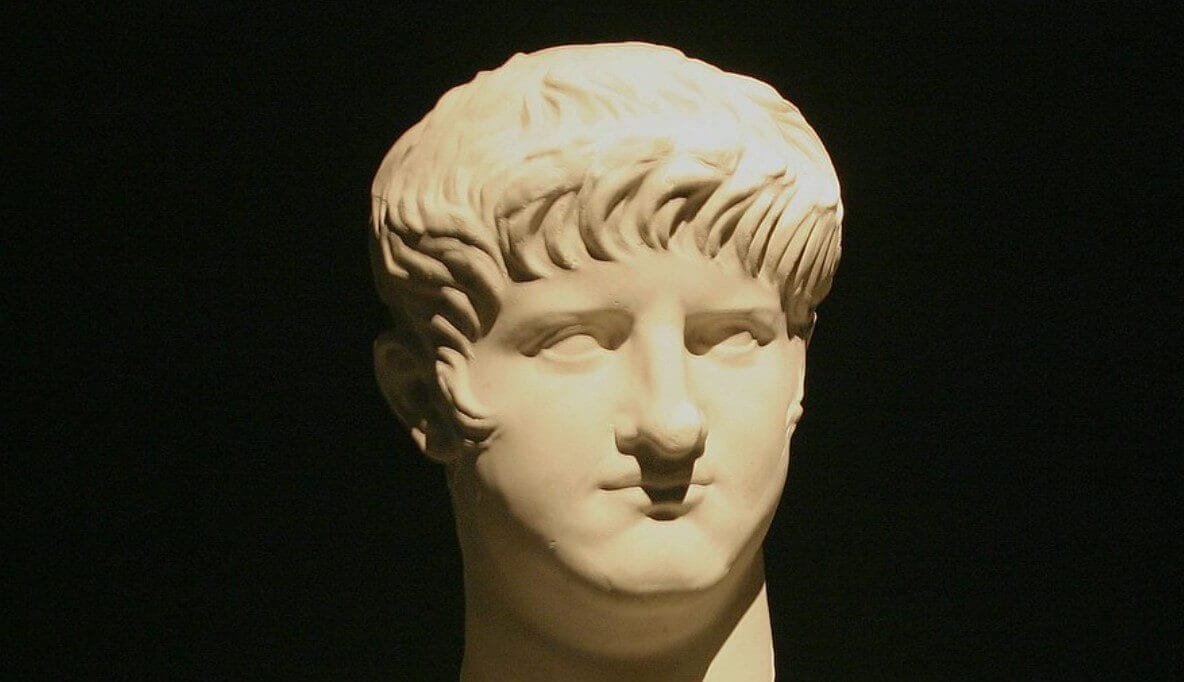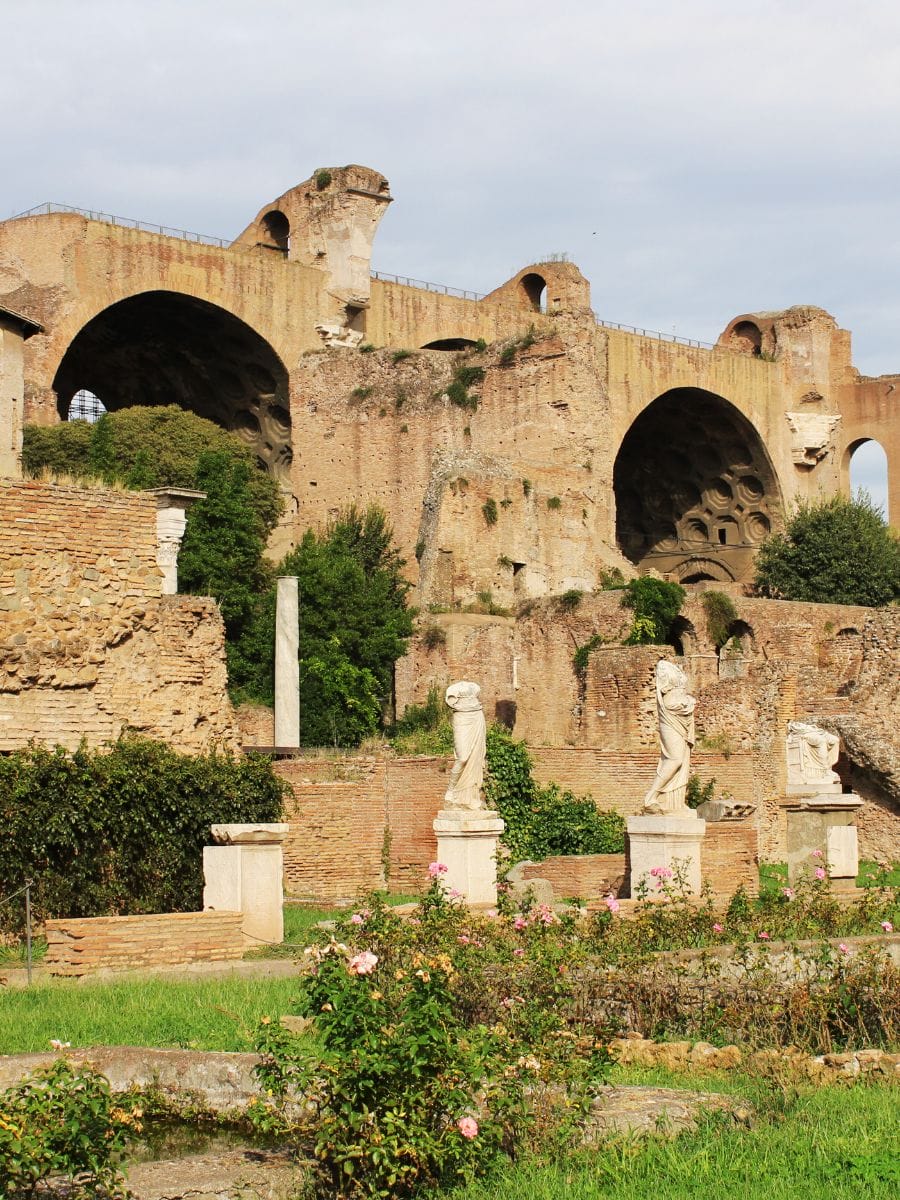
The Domus Aurea Rome: All about astonishing Nero’s palace
Thinking about exploring the hidden world of Nero’s Domus Aurea golden house? This guide tells you everything you need to know about how to visit the Domus Aurea in Rome, including ticket info, guided tour options, and how to get there from the city center.
The Domus Aurea in Rome was Emperor Nero’s grand and extravagant palace, once covered in gold and filled with art, gardens, and luxury. Learn about its fascinating history, the secrets buried beneath modern Rome, and what makes this underground site so unique. Start your visit and step inside one of the most surprising places from ancient Rome!
Contents
- 1 How to Buy Domus Aurea Tickets
- 2 Domus Aurea Location & How to Get There
- 3 Domus Aurea Opening Hours
- 4 Nero’s Golden House (Domus Aurea)
- 5 Details about Architecture and Layout
- 6 2 Little-known Domus Aurea facts that even the tour guides forget
- 7 History of the Domus Aurea
- 8 3 Best hotels nearby to Nero’s house that you can BOOK right now!
- 9 Top Attractions near Domus Aurea in Rome
- 10 Frequently Asked Questions
- 11 Conclusion
How to Buy Domus Aurea Tickets
Tickets for the Domus Aurea must be booked in advance, as entry is only possible with a guided tour. There are two main options available:
- Guided tour with Virtual Reality experience – €50 (check availability here >>)
- Standard Guided group tour – €39 (check availability here >>)
Children under 6 years old enter for free, and EU citizens aged 18–25 are eligible for reduced fares. A small reservation fee may also apply when booking online.
Each guided visit includes an expert archaeologist who will bring Nero’s Golden House to life and the virtual reality headset lets you experience the palace as it once looked, filled with light, colors, and gold leaf decorations.
Tip : Tours are only held on weekends and often sell out quickly, so it’s best to book your tickets several days in advance. You can book your Domus Aurea tickets online here, the price already includes the guided tour and VR experience.
Domus Aurea Location & How to Get There

The Domus Aurea, or “Golden House of Nero,” is one of Rome’s most fascinating archaeological sites, located right between the Colosseum and the Oppian Hill (Colle Oppio). Hidden beneath a public park, this underground palace gives you a glimpse into the extravagant lifestyle of Emperor Nero.
You’ll likely pass near the Domus Aurea while visiting the Colosseum, the Roman Forum, or the Baths of Trajan, all just a few minutes away on foot. Its central position makes it easy to include in the same day’s itinerary as these major landmarks.
Getting to the Domus Aurea is straightforward:
- By metro: Take Line B (blue line) and get off at Colosseo station. From there, it’s about a 5-minute walk uphill through Colle Oppio Park to the entrance of the Domus Aurea.
- By bus: Several city buses stop near Via Labicana and Piazza del Colosseo, including lines 51, 75, 85, 87, and 118. From these stops, it’s a short walk to the site.
- On foot: If you’re already in the ancient center of Rome, the Domus Aurea is just a 5-minute walk from the Colosseum and about 15 minutes from Piazza Venezia.
You can find the exact Domus Aurea location and directions on Google Maps below.
Domus Aurea Opening Hours
The Domus Aurea can be visited only on guided tours, which usually take place from Friday to Sunday, between 9:15 am and 5:00 pm (last entry at 3:45 pm).
Since the Nero palace is an active archaeological site, opening hours may vary depending on restoration work, so it’s always best to book your ticket in advance and check the latest schedule before your visit.
Closed on: Mondays to Thursdays, December 25, January 1, and May 1.
Tip : Try to book a morning tour for a quieter experience, or visit in the late afternoon when the sunlight filtering through the park above creates a magical atmosphere inside Nero’s underground palace.
Days | Hours |
Friday - Sunday | at 9:15 AM and 5:00 PM |
Mondays to Thursdays December 25 January 1 May 1 | Closed |
Last entry | at 3:45 pm |
Nero’s Golden House (Domus Aurea)

Want to imagine what Nero’s legendary palace once looked like? You can explore several fascinating online virtual tours that bring the Domus Aurea back to life and help you appreciate its incredible scale and design.
Reconstruction of the Palace
To understand the vastness of Nero’s Golden House, a complex that once stretched from the Palatine Hill to the Esquiline Hill, watch this detailed 3D reconstruction video.
It reveals the sheer size of the estate, with its grand halls, gardens, fountains, and artificial lake where the Colosseum now stands.
Paintings and Frescoes
This short documentary showcases the breathtaking frescoes and stucco decorations that once covered every wall and ceiling.
The video below gives a vivid sense of the palace’s original splendor, filled with mythological scenes, gold accents, and vibrant colors that inspired Renaissance artists centuries later.
The Domus Aurea Today
You can also take a 4K virtual tour of the Domus Aurea as it stands today. Many sections still preserve traces of the original frescoes, visible on the walls and ceilings.
The video below offers an incredible look inside Nero’s underground palace, a mysterious world of art, architecture, and history hidden beneath modern Rome.
Details about Architecture and Layout
You’ll definitely need to make use of a Domus Aurea floor plan when visiting, as the area is vast. Check out this location map here to help you. The golden palace of Nero had a bunch of over the top design elements.
Here is a list of a few of them below:
- a literal countryside landscape in the city-pastures, lakes and vineyards
- a 30m high statue of the man himself
over 300 entertainment rooms - internal fountains set against backdrops of white marble, angled to reflect the light
- mosaics for the first time were put on the walls and ceilings, not just on the floors
- a huge dome was designed above an 8 sided octagonal courtyard
- underneath the dome there was a moving ceiling that dropped rose petals on those being entertained below! The ceiling was moved by slaves using a pulley system
2 Little-known Domus Aurea facts that even the tour guides forget
- The palace contained – at least it is thought – no bedrooms! it seems it truly was designed as a ridiculously huge party house
- A young man was taking a stroll through Rome in the 15th century and fell into a hole. He had inadvertently discovered Nero’s palace. Soon, people were queuing up to get into the pit to see the Domus Aurea paintings
History of the Domus Aurea

Nero died in 68 AD, at which point the construction of Nero’s Domus Aurea was nearly complete. Word has it that he took a detailed interest in what was going on in Nero’s house, paying attention to every detail.
Severus and Celer were appointed as architects. They were tasked with building a sprawling home that covered part of the Palatine hill and covering more than 1.2 kilometres.
About the Emperor Nero

Nero ruled from 54AD to 68AD, from the tender age of 16. Due to his young age he was guided by his mother for the first few years. Then he killed her. Oh, and he killed a bunch of other family members too, in order to consolidate his power.
In later years, following the 64AD fire, he imposed heavy taxes in order to pay for the reconstruction. This included Nero’s golden house reconstruction. Of course, this was unpopular and led to a rebellion. He eventually committed suicide.
What does Domus Aurea mean?
Nero’s Domus Aurea means Golden House in Latin. It is known as such as the interior was not only caked in gold, but also elaborate marble and gemstones.
3 Best hotels nearby to Nero’s house that you can BOOK right now!

Rome is full of great hotels – but here we’ve selected three of the best hotels near which you can choose!
Domus Aurea 295 Apartment
This charming second floor apartment is located within a stone’s throw of the Domus Aurea and is perfect for those who want more independence. With four bedrooms and beautiful decor, you can play house in Rome for a few days. There is a minimum booking requirement of 3 nights. In spring, this will cost about €1000.
Exe Hotel
This hotel is part of the Eurostar Hotel group and is a 5 minute walk from Termini station. The decor is simple, but it is the view from the restaurant that makes this hotel special. Rooms start at €133 per night, with breakfast for 9€.
Vinci House
Located just under a kilometre from Nero’s Palace, Vinci house offers superb accommodation. Simple and sleek decor, along with a great location, mean this hotel is a real contender. Get a double room in the spring for €135 euros a night.
Top Attractions near Domus Aurea in Rome

Once you’ve toured Nero’s vast underground palace on the Oppian Hill, you’re surrounded by heavyweight Roman landmarks within minutes on foot.
From imperial forums to amphitheatres to leafy overlooks, this pocket of the city packs an absurd amount of world-class sights in a tiny radius.
- Colosseum: From Domus Aurea you spill right toward Rome’s colossal arena. Even if you don’t enter, its exterior is arresting. Step closer to feel the scale, read the scars, and picture the crowds that once roared here. Book a guided tour here >>
- Basilica Ulpia (Trajan’s Forum): A short stroll drops you into Trajan’s Forum, where the footprint of the Basilica Ulpia marks the stage of Rome’s civic power. Its remains outline one of antiquity’s largest roofed halls, humbling even in ruins.
- Arch of Constantine: Wedged between the Palatine and the Flavian amphitheatre, this victory arch is a collage of earlier imperial sculptures. Linger to see how Rome reused its own marble to recast new political messages.
- Ludus Magnus: Peek at the training school where gladiators drilled before stepping into the Colosseum. The excavated cells and arena give the blood-sport story a gritty, real-world preface.
- Palatine Hill: Climb into Rome’s mythic birthplace and seat of the emperors. Ruin-gardens, breeze, and height combine into one of the city’s most civilized places to think while looking down on the Forum.
- Roman Forum: Seconds from Domus Aurea’s exit, the Forum (get tickets here) is the hard drive of the Republic and Empire. Temples, arches, and civic shells stand in tight succession; walk slowly to parse 1,000+ years of stacked decisions.
- Basilica of San Clemente: Slip into this layered church-complex and descend time: present-day basilica, a 4th-century one below it, then a mithraeum beneath that. Few places make Rome’s vertical time so tangible.
With this cluster so close to Domus Aurea, you can pivot from Nero’s buried spectacle to Rome’s open-air hits in minutes, history here runs wall-to-wall.
Frequently Asked Questions

What is Domus Aurea?
A huge network of part of the partially excavated Nero’s palace.
Where is the Domus Aurea located?
Near the Colosseum, on part of the Capitoline Hill.
Where is the entrance to the Domus Aurea?
Entrance to the compound is accessed via the Colle Oppio Park.
Who built the Domus Aurea?
It was commissioned by Emperor Nero to replace the original palace destroyed in the 64AD fire of Rome.
When was the Domus Aurea built?
Construction began after the 64AD fire and as completed after Nero’s death in 68AD.
Can you visit Domus Aurea?
Visits are permitted only with a guided tour at weekends. Reservations are necessary in advance.
Did the Domus Aurea have windows?
Originally yes, however when the Trajan baths were being constructed the windows were filled in.
How many rooms did the Domus Aurea have?
It is estimated there were 300 rooms – the majority of which were for entertaining.
How tall was the Domus Aurea?
At least 30 metres to hold the massive statue of Nero.
What was the Domus Aurea used for?
It was primarily used for entertaining. In fact, no bedrooms have been recovered, leading historians to conclude Nero never actually slept there.
Conclusion
Few places drop you into an emperor’s head like the Domus Aurea. Even as a stripped-down shell, its scale and ambition still jolt. The mix of expert guiding, VR reconstructions, and the surreal setting beneath a city park makes it unlike any other stop in Rome.
Visit this fantastic compound of Nero’s when you are in Rome over a weekend. To plan the rest of your trip, check out our extensive guides to Rome’s many other attractions. And note that Turbopass might be a good option to get if you want one pass that bundles major sites with skip-the-line entry and transit in a single purchase.
Whether you pair it with the Colosseum or visit on its own, Domus Aurea will change how you visualise ancient Rome the moment you resurface.
Fanny, an ardent admirer of ancient history and architecture, has been fascinated by the Colosseum since her first visit to Rome in 2012. As a key contributor to the Visit Colosseum Rome blog, she brings her passion for the Roman Empire’s monumental legacy to every article and guide.

